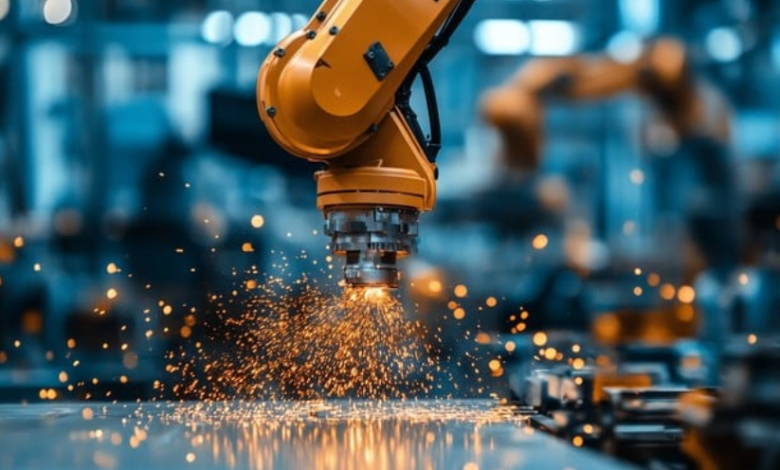How a Robotic Welding Arm Improves Efficiency in Modern Manufacturing

In modern manufacturing, efficiency, precision, and safety are essential for staying competitive. Robotic welding arms are transforming the industry by automating welding tasks that were once slow, repetitive, and prone to human error. These programmable machines use advanced sensors and welding tools to perform accurate, consistent welds, working continuously without fatigue.
By integrating robotic welding arms into production lines, manufacturers can increase output, maintain high-quality standards, reduce costs, and streamline operations to meet the growing demands of today’s market.
What Is a Robotic Welding Arm?
A robotic welding arm is an automated machine that performs welding with high accuracy and consistency. Usually fixed in one place, it is designed to repeat the same welding tasks continuously. Equipped with programmable controls and different welding tools, it can efficiently perform welding methods such as MIG, TIG, and laser welding.
Key Components
- Articulated Arm: Has multiple joints, similar to a human arm, allowing it to reach different parts of a workpiece and perform complex welds.
- Welding Torch: The tool that applies the welding arc and filler material to join metal pieces.
- Sensors and Controllers: Monitor and adjust factors like speed, temperature, and position to ensure high-quality welds.
- Power Supply Unit: Maintains stable electrical values for consistent arcs and strong welds.
Common Types of Robotic Welding Arms
- Arc Welding Robots: Use an electric arc to melt metals at the joint, suitable for a wide range of materials and thicknesses.
- Spot Welding Robots: Join metal sheets by applying pressure and heat, commonly used in automotive manufacturing.
- Laser Welding Robots: Use focused laser beams to fuse materials, offering high precision and minimal heat distortion, ideal for delicate or complex parts.
- TIG Welding Robots: These robots use Tungsten Inert Gas (TIG) welding to produce clean, precise, and high-quality welds. They are commonly used in aerospace and other high-end manufacturing where accuracy is important.
Robotic welding arms are essential in modern manufacturing because they improve efficiency, accuracy, and safety. Their ability to deliver consistent, high-quality welds makes them invaluable in industries like automotive, aerospace, and electronics.
See also: How Liveness Detection Technology Is Combating Deepfake Threats
How a Robotic Welding Arm Improves Efficiency
A robotic welding arm improves efficiency in manufacturing by automating welding tasks that were once slow, repetitive, and prone to human error. Here’s how it helps:
- Faster Production – They can operate continuously without breaks, increasing output and helping meet tight deadlines.
- Optimized Labor Use – Skilled workers can focus on complex tasks while robots handle repetitive welding, lowering labor costs.
- Minimized Downtime – Automated monitoring spots issues early, preventing interruptions and keeping production running smoothly.
Robotic welding arms increase production speed, enhance workplace safety, reduce costs, and deliver consistently high quality welds.
Case Examples of Efficiency Gains
Robotic welding arms have greatly improved efficiency in multiple industries. Here are some notable examples:
- Automotive Industry – Mass Production
Robotic welding arms are essential in car manufacturing, where they perform fast, precise, and consistent welds. This automation increases production speed, reduces errors, and allows manufacturers to produce vehicles more efficiently.
- Aerospace Manufacturing – Precision Critical
In aerospace, welds must be precise and reliable for safety. Robotic welders deliver highly accurate welds, reducing defects, maintaining structural integrity, and ensuring strict quality standards.
- Small-to-Medium Enterprises (SMEs) – Productivity Support
SMEs benefit from robotic welding by overcoming labor shortages and maintaining consistent quality. Robots help these businesses meet customer demands efficiently while freeing human workers to focus on complex tasks.
Robotic welding arms boost efficiency across industries by increasing production speed, ensuring precise and reliable welds, and supporting businesses of all sizes in maintaining quality and meeting demand.
Additional Benefits Beyond Efficiency
Robotic welding arms offer several advantages beyond just improving efficiency:
- Consistent Quality and Precision
Robotic welders are designed to repeat the same weld many times with high accuracy and consistency. This consistency reduces mistakes and imperfections that often occur with manual welding. With real-time monitoring, robots can adjust as needed to ensure each weld meets strict quality standards.
- Reduced Material Waste
Robotic welding systems are precise. They use exactly the right amount of welding material, which prevents overuse and reduces spatter. This minimizes wasted materials and rework, saving money on supplies and supporting more sustainable manufacturing practices.
- Enhanced Workplace Safety
Welding can be dangerous due to heat, sparks, and fumes. Robots perform these risky tasks, keeping human workers safe from injuries and dangerous exposure.
Robotic welding not only enhances productivity but also delivers consistent, high-quality welds while reducing material waste. These benefits make robotic welding a highly cost-effective and reliable solution for modern manufacturing.
Future Outlook of Robotic Welding Arms in Manufacturing
The future of robotic welding arms looks highly promising, driven by advances in technology and changing manufacturing demands. Key trends shaping this future include:
- AI-Powered Automation – Robots will become smarter, adjusting welding in real time to maintain high quality, reduce errors, and predict maintenance needs before breakdowns occur.
- Collaborative Robotics (Cobots) – Cobots will work safely alongside human operators, combining human expertise with robotic precision. This improves efficiency, flexibility, and addresses labor shortages.
- Industry 4.0 Integration – Connected factories with IoT and smart sensors will allow robots to communicate, optimize processes, and adapt to changes in product design or production requirements.
- Increased Efficiency and Productivity – Robotic welding arms can work continuously, follow exact welding instructions, and scale up as needed. This allows manufacturers to produce more units faster, maintain uniform quality, and reduce wasted materials.
- Market Growth – The demand for robotic welding arms is expected to rise steadily, reflecting their growing importance in modern, high-volume, and precision-driven manufacturing.
Robotic welding arms will become smarter, safer, and more adaptable, forming a cornerstone of future manufacturing operations. They will drive higher efficiency, superior quality, and greater flexibility, helping factories meet evolving market demands.
Conclusion: Robotic Welding Arms in Modern Manufacturing
Robotic welding arms are essential in modern manufacturing because they make welding more accurate, faster, and safer. By automatically handling repetitive and complex tasks, they produce consistent, high-quality welds, reduce material waste, and free skilled workers to focus on more important jobs. Industries like automotive, aerospace, and SMEs gain from increased productivity, fewer errors, and consistent results.
In the future, advances in AI, collaborative robots (cobots), and Industry 4.0 technologies will make robotic welding arms even smarter, safer, and more flexible. This will allow manufacturers to increase production, maintain quality, and adapt quickly to changing demands.
Robotic welding arms are transformative tools that boost efficiency, reduce waste, and drive high-quality manufacturing.




